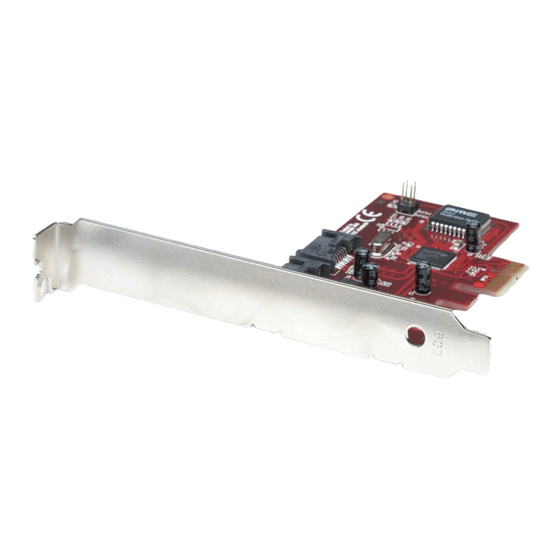Advertisement
Quick Links
Advertisement

Subscribe to Our Youtube Channel
Summary of Contents for Manhattan 160377
- Page 1 SATA 300 RAID PCI ExPRESS CARD USER MANUAL MODEL 160377 MAN-160377-UM-1006-04...
- Page 2 Thank you for purchasing the MANHATTAN SATA 300 RAID PCI Express Card, Model 160377 . ® Compliant with PCI Express 1.0a and SATA 1.0 specifications, this card adds dual internal SATA 300 ports to connect data storage and other SATA peripheral devices, and supports SATA 3 Gbps and RAID 5 data transfer rates.
- Page 3 INTRoDUCTIoN This SATA 300 RAID PCI Express Card (also known as a low-profile PCI-Express host adapter) is a controller board that supports both low-profile and regular-size PCI in one card. The card can upgrade your desktop computer to a 2-port with a SATA 300 transfer rate of 3 Gbps, and supports RAID 5, RAID 0+1, RAID 0, RAID 1 and JBOD features.
- Page 4 fEATURES • External SATA 300 (eSATA) connector • 48 bits LBA can break capacity: limit to support HDD larger than 137 GB • Supports 1-lane 2.5 Gbps PCI Express • Hot-plug capability • Supports SATA 300 transfer rate of 3.0 Gbps •...
-
Page 5: What Is Raid
whAT IS RAID? RAID (redundant array of independent disks) technology manages multiple disk drives to enhance I/O performance and provide redundancy in order to withstand the failure of any individual member without loss of data. The following RAID-related terms are used in this manual. Disk Striping (RAID 0): Striping is a performance-oriented, non-redundant data mapping technique. -
Page 6: Bios Installation (Raid Setting)
BIoS INSTALLATIoN (RAID SETTINg) Creating and deleting RAID sets is a function found in the BIOS (basic integrated operating system). During boot up, the RAID setting message will appear and pause for a few moments to allow you to choose what to do. This board will act as a normal non-RAID card when BIOS is not configured for RAID. - Page 7 Creating Mirrored Sets (RAID 1) 1. As the BIOS boots, press CTRL+S or F4 to enter the RAID BIOS utility. 2. Select "Create RAID set." Press Enter. 3. Select "RAID 1," then press Enter. 4. Select "Auto configuration." Press Enter. 5.
- Page 8 Creating a Parity RAID (RAID 5) 1. As the BIOS boots, press CTRL+S or F4 to enter the RAID BIOS utility. 2. Select "Create RAID set." Press Enter. 3. Select "RAID 5," then press Enter. 4. Select "Auto Configuration." Press Enter. 5.
- Page 9 4. Select "Spare Drives." Press Enter. 5. Select "RAID size." Press Enter. 6. Press Y to save your settings. Deleting RAID Sets 1. As the BIOS boots, press CTRL+S or F4 to enter the RAID BIOS utility. 2. Select "Delete RAID set." Press Enter. 3.
-
Page 10: Software Installation
Resolving Conflict When a RAID set is created, the metadata written to the disk includes drive connection information (primary and secondary). If, after a disk failure, the replacement disk was previously part of a RAID set (or used in another system), it may have conflicting metadata, specifically in reference to the drive connection information. - Page 11 4. Press Enter to continue with text mode setup. 5. Follow the Setup instructions to select your choice for partition and file system. 6. After Setup examines your disks, it will copy files to Windows 2000 installation folders and restart the system. The Setup program will continue and finish the installation after restart. 7 .
- Page 12 8. The wizard will now copy the required files to the system and start the driver. When the wizard displays a completion dialog, click "Finish" to exit the wizard. 9. See Verifying Controller Installation Under Windows to verify the PCI Express Card was installed correctly.
- Page 13 3. The system will go through the enumeration process and install the driver. At the end of the process, click "Yes" to reboot your system if necessary. 4. See Verifying Controller Installation Under Windows to verify the PCI Express Card was installed correctly.
-
Page 14: Specifications
SPECIfICATIoNS ort Specifications • Two internal SATA 300 ports • Compliant with serial ATA 1.0 specifications • 48-bit LBA supports HDD larger than 137 GB • Supports two independent SATA channels • Silicon serial controller • Independent link, transport and data FIFO, and command fetch, scatter/gather and command execution •... - Page 15 System Requirements • Windows 2000/XP/Server 2003/Vista • PCI Express-enabled system with an available Express Card slot • CD-ROM drive Package Contents • SATA 300 RAID PCI Express Card, x1 lane • Regular and low-profile brackets • User manual and driver CD...
- Page 16 Are you completely satisfied with this product? Please contact your MANHATTAN dealer with comments or questions. ® Copyright © MANHATTAN All products mentioned are trademarks or registered trademarks of their respective owners.

















Need help?
Do you have a question about the 160377 and is the answer not in the manual?
Questions and answers